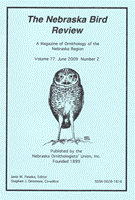Nebraska Ornithologists' Union

Nebraska Bird Review
Date of this Version
2000
Document Type
Article
Abstract
On 2 December 1999, I was birding at the east end of Lake Ogallala in Keith County. I was scanning the large diving duck flock just above the Keystone diversion dam when I noticed a scaup-like duck with a thin crest. I quickly realized that the bird was a male Tufted Duck. I carefully studied the, bird from 9:32-10:28 a.m. The bird spent all of its time actively foraging with a large flock of Greater and Lesser Scaup. It was approximately the same size as a Lesser Scaup. The head shape was rounded like a scaup, not "peaked" like a Ring-necked Duck. The bill was bluish with a black tip and a narrow white subterminal band, unlike the bill of a male Ring-necked Duck (black tip with a broad white subterminal band). The bill also lacked the white base of the bill of a male Ring-necked Duck. The eye was yellow. The head appeared dark-colored, except that it had a purplish sheen at some angles. The most conspicuous feature was the narrow crest, or tuft, which I estimated to be at least 5 cm long. This was visible at all times, except that it was sometimes flattened against the head immediately after the bird surfaced after a dive. The flanks were similar to those of a male Ring-necked Duck, except that they were a dirty white color instead of gray. The flanks were not clean white like those of many male Lesser Scaup. The mantle was conspicuously black, and lacked the pale vermiculations of a male Lesser Scaup. In flight, the upperwings were dark with a bold white stripe on the secondaries and inner primaries. The upperwing pattern very closely resembled that of a Greater Scaup. I did not note the tail pattern. On the basis of the flank color and long tuft, I aged the bird as an adult male molting into alternate plumage. According to Toochin (1998), the molt sequence of Tufted Ducks is consistent with this conclusion.


Comments
Dinsmore in Nebraska Bird Review (June 2000) 68(2). Copyright 2000, Nebraska Ornithologists' Union. Used by permission.